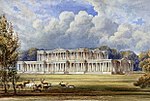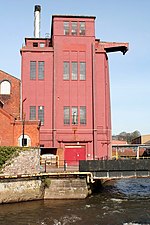Killerton

Killerton is an 18th-century house in Broadclyst, Exeter, Devon, England, which, with its hillside garden and estate, has been owned by the National Trust since 1944 and is open to the public. The National Trust displays the house as a comfortable home. On display in the house is a collection of 18th- to 20th-century costumes, originally known as the Paulise de Bush collection, shown in period rooms. The estate covers some 2590 hectares (25.9 km2, 6400 acres). Included in the estate is a steep wooded hillside with the remains of an Iron Age hill fort on top of it, known as Dolbury, which has also yielded evidence of Roman occupation, namely a triple-ditched Roman fort or marching camp which is still visible in aerial photographs, despite heavy ploughing within the hill fort.Killerton House itself and the Bear's Hut summerhouse in the grounds are Grade II* listed buildings. The gardens are Grade II* listed in the National Register of Historic Parks and Gardens.
Excerpt from the Wikipedia article Killerton (License: CC BY-SA 3.0, Authors, Images).Killerton
Exeter Broadclyst
Geographical coordinates (GPS) Address Website External links Nearby Places Show on map
Geographical coordinates (GPS)
| Latitude | Longitude |
|---|---|
| N 50.7915 ° | E -3.4578 ° |
Address
Killerton House
EX5 3LE Exeter, Broadclyst
England, United Kingdom
Open on Google Maps










